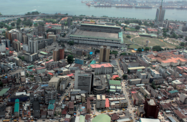President Goodluck Jonathan and his economic team began 2012 with a renewed focus on their Agenda for National Transformation (ANT), targeting wholesale reform across a range of economic sectors.
The new agenda, which was designed to complement the Vision 20:2020 development strategy, contained a number of macroeconomic objectives, led by the aim to maintain real GDP growth at around 7-8%. Other targets included reducing the federal government’s deficit to 1.5% of GDP by 2015 from 3.5% in 2010, removing a costly fuel subsidy, increasing capital spending and boosting non-oil revenues.
Achieving these objectives has required and will require a number of serious macro-level reforms, something that has often stymied attempts in the past to address structural issues in Nigeria’s economy. The size of the hurdles the President and his economic management team – a 24-member council featuring representatives from both the public and private sectors – faced in 2012 have reinforced this, and implementing the agenda was not without challenges.
The removal of the gasoline subsidy, a key component of fiscal saving, triggered a national strike, leading to a partial reversal of the decision two weeks later. The on-going turmoil that has struck at the privatisation process in the power sector – another area vital to the transformation agenda – with two key officials removed in recent months, has also dampened investor interest in a sector central to growth prospects.
However, despite short-term ups and downs and the broader uncertainty over reforms in the medium-term, long-term fundamentals, including Africa’s largest population and a wealth of natural resources, have helped it to maintain its overall momentum. The IMF maintained a positive outlook for baseline economic growth. Non-oil GDP growth was expected to reach 7.8% for 2012, while overall GDP expansion was forecast to rise slightly to 6.9%.
Efforts to address weaknesses in the banking industry also paid dividends in 2012. Remedial measures, which included bail-outs, forced mergers and the purchasing of $11bn in non-performing loans by the Asset Management Corporation of Nigeria (AMCON), resulted in an improved sector performance. In July, the IMF announced that “financial soundness indicators point to continued improvements in the health of the banking system. NPLs have declined sharply following their purchase by [...] AMCON and credit has stopped declining”. Third-quarter results for Nigeria’s banks reflected the sector’s shift onto a sounder footing, with significant gains in net profit posted by most of the larger players.
The nation’s capital markets indicated similar buoyancy over the year, with the Nigerian Stock Exchange (NSE) recording a 25.5% expansion in the first three quarters of 2012. Foreign interest in the NSE remained strong, with international investors accounting for 70% of stock ownership, while a year-on-year (y-o-y) rise to 30% from 20% in domestic ownership was viewed by the president of the exchange as a sign that Nigerians were making a return to the market.
Nigeria’s petroleum sector, which accounts for around 15% of GDP, recorded higher production over the year as a result of a decrease in crude oil theft in the Niger Delta and the re-entry into previously abandoned fields by major players. According to the central bank, crude oil production averaged 2.26m barrels per day (bpd) in third-quarter 2012, representing a y-o-y increase of 6.1%.
The industrial sector also gave a better performance, with the central bank’s industrial production index making y-o-y gains in each of the first three quarters of 2012. The bulk of the growth was attributed to increased activities in the electricity, mining and manufacturing sub-sectors.
However, while the manufacturing capacity utilisation rate showed consistent gains in the first three quarters of 2012, its modest contribution to GDP has also prompted some concern. Early in the year, the Minister for Trade and Investment Olusegun Aganga said the government aimed to increase manufacturing’s GDP input from its current level, estimated at between 3% and 5%, to at least 10%. The Manufacturers Association on Nigeria welcomed the announcement, while calling for a system of relief and incentives to be extended to all segments.
The government also announced in 2012 that it would like to raise the contribution of tourism to GDP from its current level of 1.6%. Speaking at the Abuja Carnival, a four-day cultural festival, in late November, Vice President Namadi Sambo suggested that the time was ripe for Nigeria to build strong, sustainable growth in tourism. “The sector provides economic development options with high capacity for empowerment and employment opportunities, poverty reduction as well as good returns for investment,” he said. Around 840,000 Nigerians are currently employed directly within the country’s tourism industry, representing only 1.4% of the labour force.
The government is expected to continue its drive to diversify the economy by reinvigorating established sectors such as manufacturing and encouraging growth in newer areas such as tourism. The country also plans to build on Nigeria’s position as Africa’s top destination for foreign direct investment (FDI) as it looks to secure funding for growth sectors. In 2012, the government announced an intention to boost FDI to $16bn in 2013 from the $8.9bn it attracted in 2011.
However, while the outlook of the nation’s economic growth remains positive, the Central Bank of Nigeria has identified a number of short- and mid-term downside risks. These include security challenges arising from religious conflict in some states and continuing corruption scandals. The country is also counting the economic cost of flooding, which affected several parts of the country in 2012 and resulted in a slowdown in agricultural-sector growth in the third quarter.

